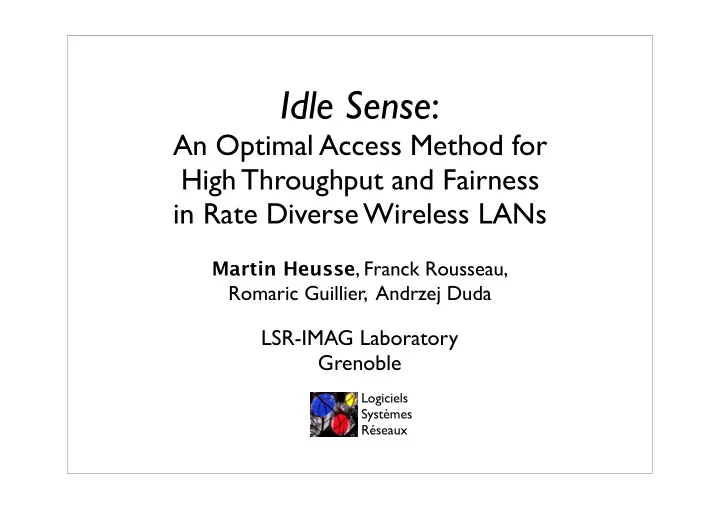

Idle Sense : An Optimal Access Method for High Throughput and Fairness in Rate Diverse Wireless LANs Martin Heusse , Franck Rousseau, Romaric Guillier, Andrzej Duda LSR-IMAG Laboratory Grenoble Logiciels Systèmes Réseaux
Outline • 802.11 DCF principles and shortcomings • Towards a better access method • Idle Sense principles and properties • Performance evaluation 2
802.11 DCF in a nutshell 3 … Data + ACK Data + ACK 2 … Data exponential backoff collision CW � 2 x CW 1 … Data Host # time DIFS Elapsed backoff Medium busy Residual backoff 3
Known shortcomings of DCF • Under optimal throughput for N > 4 - Hosts are too aggressive ⇒ collisions - CW too small, not enough time spent in contention • Exponential backoff - Good short term fairness for N=2, degrades for larger N • Performance anomaly in rate diverse cells - Slow host limits the throughput of faster hosts 4
Known shortcomings of DCF • Contention control in DCF - “Bad day” effect ° If a host looses frames due to bad transmission conditions, it performs frequent exponential backoffs ° Increased CW lowers the transmission attempt probability - Physical capture effect 5
Physical layer capture effect • The stronger signal in a collision may be successfully received • It causes long term unfairness - Farther host has a greater average contention window (Kochut et al. , ICNP'04) 6
Towards a better access method • Keep good aspects of DCF - No explicit information exchange - Keep backoff procedure: random backoff • Modifications - No exponential backoff ° make hosts use similar values of CW ⇒ fairness - Adapt CW to varying traffic conditions ° more hosts, bigger CW; less hosts smaller CW ° do not change CW upon frame loss 7
Idle Sense • Observe the number of idle slots - Channel load indicator • Control CW - Adjust CW to the current state - Optimal operation in all conditions ° What is the optimal CW? ° How it relates to the number of idle slots? 8
Optimal CW 150 2 4 6 100 8 10 Cost 50 0 0 50 100 150 200 250 300 CW Cost function: Proportion of time spent in collisions or contention Minimizing the cost ⇒ Maximizing throughput (Calì et al ., Transactions on Networking, 2000)
target Optimal CW n ̄ i 600 5.5 optimal CW CW proportional 400 to N n i n ̄ i converges quickly 4.5 200 3.5 0 0 10 20 30 40 50 0 10 20 30 40 50 N N n ̄ i : average number of idle slots between transmission attempts
Idle Sense • Hosts track n ̄ i and make it converge to the target value - Each host estimates n ̄ i - Rises/Lowers CW when n ̄ i too small/big target compared to n ̄ i - Adjusting CW is done according to AIMD ⇒ all hosts converge to a similar value of CW 11
Example Host 3 joins DIFS 1 2 1 1 3 2 1 3 n i 8 6 5 5 4 2 0 1 CW 3 =25 CW 1 =28 n ̂ i = 6.3 n ̂ i = 3.7 n ̂ i = 2 CW 2 =25 CW1=25 CW1=30 CW3=30 n ̂ i = 6.3 n ̂ i = 3.7 2 active hosts CW2=22 CW2=26 target = 5.7) ( α = 1/1.2, ε =0.01, ntrans=3, n ̄ i
Properties • Contention control independent of frame loss detection - No “bad day” effect - Solves the physical layer capture effect • Short term fair • Fixes performance anomaly - Time fairness achieved by scaling CW according to the transmission rate • Hidden terminal problem: use RTS/CTS • No hardware modification required 13
Properties: Channel adaptation • With Idle Sense , the collision probability P c is known and bounded (after convergence) - Frame loss probability P err ≈ 1- P c - P ok ° P ok can be observed • Provides a new means for setting the right transmission rate - Change rate when P err exceeds a given threshold - May be combined with SNR measurements 14
Performance evaluation • Throughput • Fairness: Jain index • Convergence speed • Time fairness 15
Throughput 0.35 802.11b Idle Sense 0.3 Throughput (Mb/s) 0.25 0.2 0.15 0.1 0.05 0 20 40 60 80 100 120 140 160 180 200 N
Fairness 50 hosts 1 0.9 0.8 0.7 Jain index 0.6 0.5 0.4 0.3 Idle Sense 802.11b DCF 0.2 Slow Decrease AOB 0.1 0 10 20 30 40 50 Normalized window size
Convergence speed 250 Host staying for the whole run Host staying for a small number of transmissions 200 150 CW size 100 50 0 0 1000 2000 3000 4000 5000 6000 7000 Transmission number
Time fairness 1000 Host transmitting at 11Mbps Host transmitting at 1Mbps 800 Time spent transmitting (s) 600 400 200 0 802.11b Idle Sense + Time fairness 19
Conclusions • Performance gains • Addresses many issues in wireless LANs - Main property: it uncouples frame loss and contention control • Enables other improvements - eg. give more weight to the access point 20
Recommend
More recommend